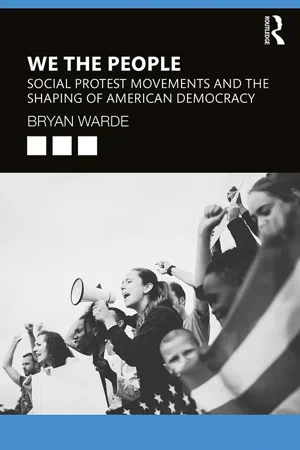History
Civil Rights Protests
Civil rights protests refer to organized demonstrations and actions aimed at achieving equal rights and ending discrimination against marginalized groups, particularly African Americans in the United States. These protests were pivotal in the struggle for civil rights and led to significant legislative and societal changes, such as the Civil Rights Act of 1964 and the Voting Rights Act of 1965.
Written by Perlego with AI-assistance
Related key terms
2 Key excerpts on "Civil Rights Protests"
- eBook - ePub
We the People
Social Protests Movements and the Shaping of American Democracy
- Bryan Warde(Author)
- 2020(Publication Date)
- Routledge(Publisher)
Martin Luther King, Jr., Bayard Rustin, Ralph Abernathy, Rosa Parks, Medgar Evers, Ella Baker, Roy Wilkins, Andrew Young, Jessie Jackson, Coretta Scott King, Pauli Murray, Dorothy Height, Diane Nash, Fannie Lou Hamer, Stokely Carmichael, Nina Simone, Harry Belafonte, Andrew Goodman, James Chaney, Michael Schwerner, Viola Liuzzo, Malcolm X, President Lyndon B. Johnson, Daisy Bates, Septima Poinsette Clark.Civil Rights Groups
Student Nonviolent Coordinating Committee (SNCC), Fellowship of Reconciliation (FOR), the Southern Christian Leadership Conference (SCLC), Congress of Racial Equality (CORE), and the National Association for the Advancement of Colored People (NAACP).Figure 1.3 Civil rights march, 1964Source: National ArchivesThe catalyst for the 1960s civil rights movement was the decades-long post-reconstruction struggle of Black Americans for equality in the former slave-holding Southern states. It was referred to as post-reconstruction because the promise of equality from reconstruction did not come to fruition, as a result of Jim Crow laws (Urofsky, 2017). These laws, which came into being from the late 1870s to1892, mandated the racial segregation of all public places – schools, transportation systems, hospitals, parks, restaurants, theaters, and the workplace, to name a few. Additionally, they included poll taxes and literacy tests, and when necessary, violence and intimidation to prevent Black Americans from exercising their voting rights (Urofsky, 2017). The goal of the civil rights movement was to end “dejure” segregation.To do this, the movement, under the leadership of Martin Luther King, Jr., chose the tactics of nonviolence and passive resistance. These tactics would alert the national public and politicians to the ills of segregation. The movement staged sit-ins at segregated public spaces, marches, freedom rides, boycotts, and demonstrations, often being the victims of violent responses from police and local people opposing the call for desegregation (Documents of Freedom, n.d.). Greatly aiding the civil rights movement and their cause was the national media coverage, which showed the horrors of the violent response to the peaceful dissent of the civil rights marchers. In addition to nonviolence and passive resistance, the movement also put political pressure on the then-president, Lyndon B. Johnson, to pass federal legislation ending dejure segregation in the United States, which he did, passing two society-changing policies, the (Civil Rights Act of 1964, 1964) and the (Voting Rights Act of, 1965) (Documents of Freedom, n.d.). - eBook - ePub
Protest and Dissent
NOMOS LXII
- Melissa Schwartzberg(Author)
- 2020(Publication Date)
- NYU Press(Publisher)
Social protest can be a reaction to an inadequate or corrupt political process or market economy—mass demonstrations for women’s suffrage are a paradigmatic example of such a protest, since it was a protest movement that aimed to correct the political process itself. But any protest that advances a cause that hasn’t gotten a fair shake in the political process qualifies. Protest can also be a reaction to a violation of fundamental rights—here the fairness of the political or market processes that brought about the challenged result are irrelevant because a violation of rights is never justified. Protest can also be an established part of a political system or market—such as labor picketing sanctioned under the National Labor Relations Act.Protest, then, can be a disruption of the political and economic status quo, or it can be an expected part of the day-to-day operation of the system—politics by other means. A proviso. When I criticize certain protests, I do not intend to imply a legal argument concerning the “rights” of individuals and groups to assemble and express themselves. Although some of my argument has implications for First Amendment doctrine, which I will explore in a brief conclusion, my central argument concerns the wisdom and civic-mindedness of protest—not its legality.Costs
There are costs to the overuse of protest.Inconvenience and Disruption
Most obviously, protests and mass demonstrations are time-consuming and inconvenient for nonparticipants: They block streets in congested cities, disrupting normal commuting and commerce. This may seem trivial as compared to the importance of a political cause, but inconvenience is not the only problem. Blocked streets can impede the movement of emergency vehicles, resulting in life-threatening delays. Large, unruly crowds are magnets for criminals, sociopaths, and disruptive elements—as a consequence, violence and destruction are always a risk, and police must be deployed at significant public expense.
Learn about this page
Index pages curate the most relevant extracts from our library of academic textbooks. They’ve been created using an in-house natural language model (NLM), each adding context and meaning to key research topics.

